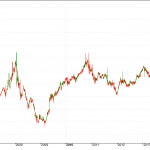Stock split involves division of the equity shares of a company by lowering their face value. This increases the number of shares outstanding without changing the actual market capitalization of the company. For an investor, it increases the number of shares that he/she holds but there is a corresponding fall in the price of the shares.
The day the split is carried out is called the record date. After the split, shares trade at the new lower price on the exchanges.
Suppose a company has 10 crore outstanding shares of Rs 10 face value and it announced a split to Rs 5 face value per share. Therefore, one share of face value Rs 10 will become 2 shares of Rs 5 face value. Therefore, an investor holding 100 shares of the company will now have 200 shares after the stock split.
Just recently on Nov 20th, 2014, State Bank of India (SBI), for the first time ever, got its share price split into 1:10. This means investors will get 10 shares for every one share they hold. The stock price, as a result, fell by around one-tenth, from Rs 2,700 to Rs 270.
So, when the split goes into effect, the investor who hold 100 shares of SBI worth Rs. 2,97,000 (2970 x 100) will get additional 900 shares to make his total shares of 1000 which will worth the same value i.e.Rs. 297 x 1000 = 2,97,000. So, the investors portfolio value remains the same i.e. Rs. 2,97,000 but the price per share just becomes lower.
Many other stocks after witnessing a fast rise in the markets have also announced the splitting of their shares price. Stocks like Axis Bank, Punjab National Bank (PNB) have announced the splitting of the share prices from one to five.
Why do companies split stock prices and what’s in it for the investors?
Splits don’t change anything fundamentally about a company or its valuation, but they tend to make a company’s stock more accessible to a large number of investors. By making their stock attractive to individual investors, companies help ensure that their shareholder base is as wide as possible. A large shareholder base also helps deter small groups of shareholders from gaining control or exerting too much influence.
Stock split does not result in a change in investor wealth. Nor does it affect the company’s business model and financial position. Thus, it does not in any way indicate how the company is going to perform in the future. While increase in liquidity after the split has some benefits, it cannot be the sole factor for investing.
Reverse splits
The opposite of the standard stock split is the reverse split. This occurs when a company exchanges multiple shares for a single new share. For example, if a stock is selling for Rs. 1, the company could do a reverse split and exchange two old shares for one new share priced at Rs.2.
Why would a company do a reverse split?
In most cases, the stock’s price has fallen dramatically and the company wants to make its shares look more valuable. The reverse split may also be needed to raise the stock’s price to the minimum needed for listing on an exchange. Either way, reverse splits are generally a bad sign and a warning to investors to be extra cautious.
Do splits matter for investors? Or are they just an attempt to attract more investors?
Every investor should not take the investment decision on the parameter that the stock price has split-ed and it is now worth investing rather should consider the fundamental and other important considerations including the market position to understand and conclude about its future prospects.
KNOWLEDGE IS POWER!




